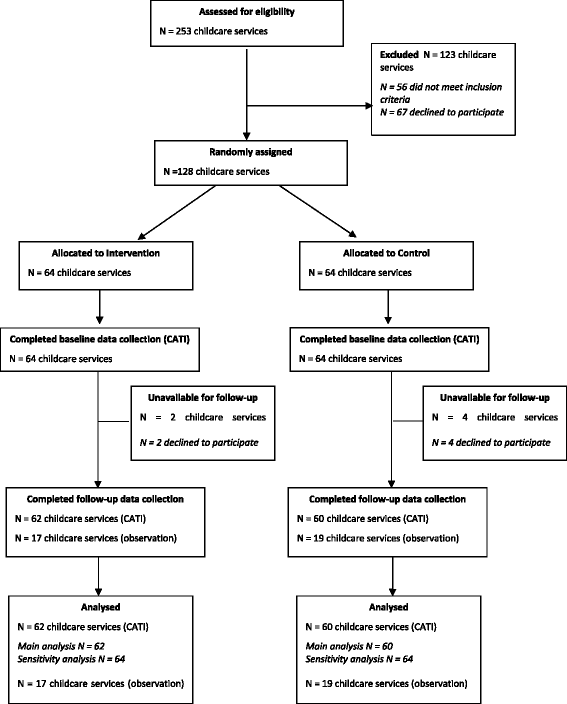Effectiveness of an intervention to facilitate the implementation of healthy eating and physical activity policies and practices in childcare services: a randomised controlled trial
- PMID: 26498746
- PMCID: PMC4619985
- DOI: 10.1186/s13012-015-0340-z
Effectiveness of an intervention to facilitate the implementation of healthy eating and physical activity policies and practices in childcare services: a randomised controlled trial
Abstract
Background: The primary aim of this study was to evaluate the effectiveness of an intervention to increase the implementation of healthy eating and physical activity policies and practices by centre-based childcare services. The study also sought to determine if the intervention was effective in improving child dietary intake and increasing child physical activity levels while attending childcare.
Methods: A parallel group, randomised controlled trial was conducted in a sample of 128 childcare services. Intervention strategies included provision of implementation support staff, securing executive support, staff training, consensus processes, academic detailing visits, tools and resources, performance monitoring and feedback and a communications strategy. The primary outcome of the trial was the proportion of services implementing all seven healthy eating and physical activity policies and practices targeted by the intervention. Outcome data were collected via telephone surveys with nominated supervisors and room leaders at baseline and immediately post-intervention. Secondary trial outcomes included the differences between groups in the number of serves consumed by children for each food group within the Australian Guide to Healthy Eating and in the proportion of children engaged in sedentary, walking or very active physical activity assessed via observation in a random subsample of 36 services at follow-up.
Results: There was no significant difference between groups for the primary trial outcome (p = 0.44). Relative to the control group, a significantly larger proportion of intervention group services reported having a written nutrition and physical activity policy (p = 0.05) and providing adult-guided activities to develop fundamental movement skills (p = 0.01). There were no significant differences between groups at follow-up on measures of child dietary intake or physical activity.
Conclusions: The findings of the trial were equivocal. While there was no significant difference between groups for the primary trial outcome, the intervention did significantly increase the proportion of intervention group services implementing two of the seven healthy eating and physical activity policies and practices. High levels of implementation of a number of policies and practices at baseline, significant obesity prevention activity in the study region and higher than previously reported intra-class correlation of child behaviours may, in part, explain the trial findings.
Trial registration: Australian Clinical Trials Registry (reference ACTRN12612000927820 ).
Figures
References
-
- World Cancer Research Fund/American Institute for Cancer Research. Food, nutrition, physical activity, and the prevention of cancer: a global perspective. 2007. http://www.dietandcancerreport.org/cancer_resource_center/downloads/Seco.... Accessed 30 Jan 2015.
-
- Ezzati M, Lopez A, Rodgers A, Murray C. Comparative quantification of health risks: global and regional burden of disease attributable to selected major risk factors. World Health Organization. 2004. http://www.who.int/healthinfo/global_burden_disease/cra/en/. Accessed 30 Jan 2015.
-
- Dietz WH. Critical periods in childhood for the development of obesity. Am J Clin Nutr. 1994;59(5):955–9. - PubMed
Publication types
MeSH terms
LinkOut - more resources
Full Text Sources
Other Literature Sources
Medical


